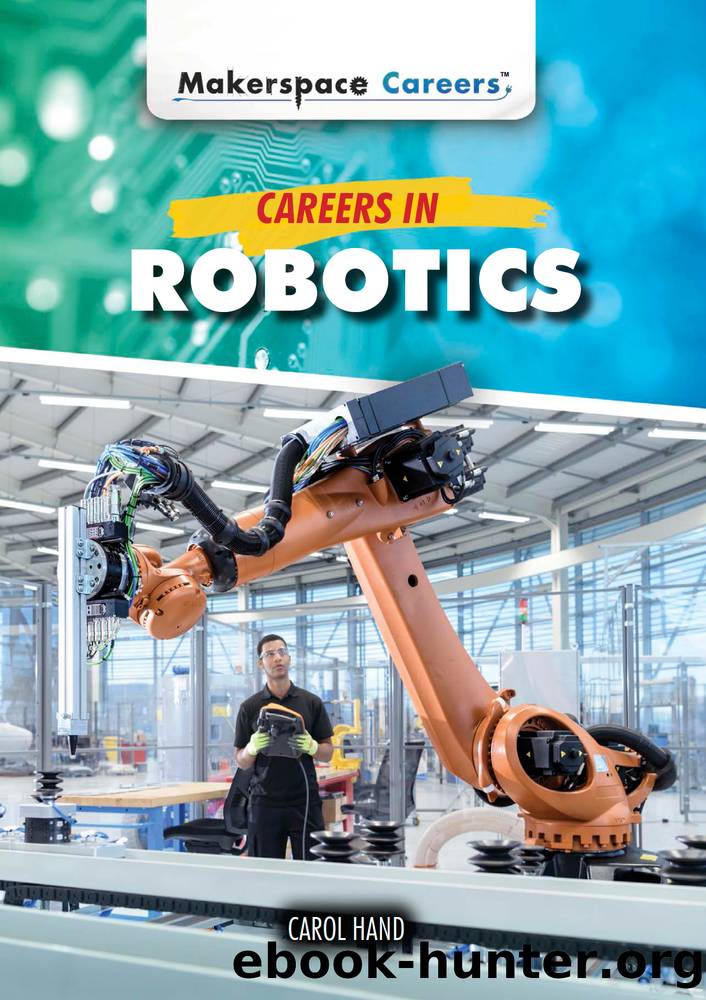Careers in Robotics by Carol Hand

Author:Carol Hand
Language: eng
Format: epub
Publisher: The Rosen Publishing Group, Inc
Published: 2019-06-10T00:00:00+00:00
The Curiosity rover is part of the NASA Mars Science Laboratory mission. In this artistâs depiction, Curiosity uses its sensors to investigate a rock surface.
TALON, a UGV made by Foster-Miller, weighs less than 100 pounds (45 kg), runs on treads, and has seven speeds, with a top speed of 6 feet (1.8 meters) per second. It is controlled by a joystick and can adapt to different situations. TALON was used for search and rescue when the World Trade Center fell in 2001. It has been used in Afghanistan and Iraq to dispose of live grenades and improvised explosive devices. There are even UUVs, or unmanned underwater vehicles, similar to tiny submarines, which carry out tasks such as mine warfare, intelligence, surveillance, and reconnaissance.
Previously, recruits practiced on pop-up or stationary targets. The first time they shot at a live target was on the battlefield. Marathon Targets, an Australian company, has developed AI robots that react like human targets and can train military recruits how to shoot at live targets. Like self-driving cars, they orient themselves using light detection and ranging (lidar) sensors. They run to rescue wounded âcomrades.â If hit in a vital organ, they fall over, but if only wounded, they come after the shooter.
THE FUTURE OF MILITARY ROBOTS
Researchers have big plans for future military robots. Marathon, for example, is considering robot medics that will pull wounded soldiers out of firefights and robots that can navigate tunnels and other dangerous underground spaces. The July 2018 rescue of twelve boys and their coach from a cave in Thailand would have been much easier with such robots. Many experts think that, in the near future, soldiers from rich countries will fight wars without ever coming into contact with enemy combatants. Robots will do reconnaissance and patrolling and will kill the enemyâall while being controlled from a distance. Those who favor robot use think that such robots will decrease battlefield casualties and will not make errors or suffer from fatigue or emotion. But there are concerns. Some think that, if US soldiers are less likely to be killed, US citizens may become more tolerant of our government engaging in wars overseas. Also, when two countries engage in a robots-only conflict, how is the winner determined?
Download
This site does not store any files on its server. We only index and link to content provided by other sites. Please contact the content providers to delete copyright contents if any and email us, we'll remove relevant links or contents immediately.
Pale Blue Dot by Carl Sagan(4887)
Cracking the GRE Premium Edition with 6 Practice Tests, 2015 (Graduate School Test Preparation) by Princeton Review(4206)
Pocahontas by Joseph Bruchac(4167)
Unfiltered by Lily Collins(3947)
The Emotionary: A Dictionary of Words That Don't Exist for Feelings That Do by Eden Sher(3301)
The Daily Stoic by Holiday Ryan & Hanselman Stephen(3215)
Factfulness_Ten Reasons We're Wrong About the World_and Why Things Are Better Than You Think by Hans Rosling(3187)
The President Has Been Shot!": The Assassination of John F. Kennedy by Swanson James L(3035)
The 48 laws of power by Robert Greene & Joost Elffers(2993)
Sapiens and Homo Deus by Yuval Noah Harari(2970)
Rogue Trader by Leeson Nick(2962)
The Innovators: How a Group of Hackers, Geniuses, and Geeks Created the Digital Revolution by Walter Isaacson(2784)
The Rape Of Nanking by Iris Chang(2764)
Gettysburg by Iain C. Martin(2717)
Almost Adulting by Arden Rose(2645)
The Plant Paradox by Dr. Steven R. Gundry M.D(2531)
500 Must-Know AP Microeconomics/Macroeconomics Questions(2520)
In the Woods by Tana French(2520)
Make by Mike Westerfield(2274)
